모유 분비량은 자연 수요공급 법칙에 따라 좌우된다, Amount of breast milk secretion is upon laws of supply and demand
- 모유의 분비량은 여러 가지 조건의 영향을 받지만 수요공급 법칙에 따라 모유 분비량을 주로 결정된다.
- 충분한 양의 모유가 계속 분비되도록 하려면 가능한 분만 후 바로 아기에게 젖꼭지를 물려 빨리는 것이 좋다.
- 신생아에게 모유 이외 다른 신생아용 음식물 즉, 인공영양, 물, 포도당 물 등 보충용 음식물은 아무것도 먹이지 않는다.
- 아기가 필요로 하는 만큼 젖을 빨아먹으면 필요로 하는 만큼 엄마의 젖이 분비된다. 아기가 더 많은 젖을 먹으려 젖을 더 빨면 더 많은 양의 젖이 자연적으로 분비된다. 이런 이유로 ‘모유의 분비량은 수요공급 법칙에 따라 결정 된다’고 할 수 있다.
- 가령 젖 먹는 아기에게 모유 대신 식수를 많이 먹이면 무언가를 마시고 싶은 갈증이 생기지 않는다. 결국 아기가 젖을 적게 먹게 되어 젖의 분비량도 자연적으로 감소된다.
- 젖을 먹는 아기에게 젖 이외 분유나 인공영양 등 보충용 음식물을 가외로 더 먹이면 아기가 필요로 하는 수분, 칼로리, 영양분을 인공영양 등 보충용 음식물에서 이미 섭취했기 때문에 그 당시 더 섭취할 영양분과 칼로리가 없다.
- 그래서 모유를 먹을 필요가 없다. 모유를 더 먹을 필요가 없기 때문에 젖을 빨아 먹지 않고 모유 수요량이 줄어들고 젖이 적게 분비 된다. 결과적으로 젖의 분비량도 자연스럽게 줄어들 것이다.
- 이렇게 쉽게 이해할 수 있는 수요공급 법칙에 따라 모유수유의 양과 모유 분비량이 결정된다.
- 모유도 먹이고 인공영양도 먹이는 식으로 혼합수유를 하면 젖 이외로 먹은 보충용 인공영양의 양만큼 모유의 수요량이 줄어들고 모유의 분비량도 줄어든다. 따라서 모유수유를 성공적으로 하는데 문제가 생길 수 있다. 또 중요한 것은 아기도 엄마도 언제 젖을 먹이고 얼마나 젖을 먹고, 언제 얼마나 젖을 먹여야 되는지 모우수유 자연 원칙이 어긋나서 혼합수유가 결국에는 “혼동수유”가 된다는 것이다.
- 생후 3~4주 동안 신생아는 하루에 8~12번 젖을 먹는다. 특히 이 기간 동안에 모유 이외 인공영양, 물, 포도당물 등 보충용 음식물을 먹여야 할 때는 꼭 의사와 상담한 후 먹이는 것을 결정하는 것이 좋을 것이다.
- 참고로 분만 후 첫 1~3일 동안에도 갓 태어난 아기가 매 1~2시간 마다 젖을 빨아도 주로 초유가 분비되고 변이 모유나 성숙 모유가 분비되지 않는다.
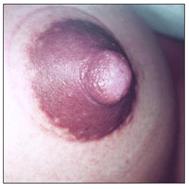
사진 4-64. 수유모의 젖꼭지와 유두륜
Copyright ⓒ 2011 John Sangwon Lee, MD., FAAP
| 혼합수유가 “혼동수유”가 될 수 있다. |
| 모유가 충분한지, 부족한지 어떻게 아나? How to know the breast milk supply is sufficient or insufficient? |
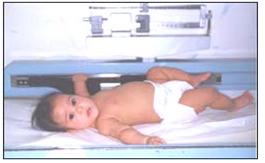
사진 4-65. 모유를 먹는 아기의 체중을 하루 간격으로 또는 수유하기 전 후에 재어보고 아기가 모유를 충분히 먹고 있는지 알아볼 수도 있다.Copyright ⓒ 2011 John Sangwon Lee, MD., FAAP
- 유방의 크기에 관계없이 수유모의 유방은 성장 발육하는 아기에게 필요로 하는 젖의 양이 충분히 분비될 수 있다.
- 다시 말하면 유방이 크건 작건 한 아기가 먹고 자랄 수 있도록 충분한 젖이 분비된다. 쌍둥이 아기를 낳아서 아기 둘을 한꺼번에 키워낼 수 있을 만큼 젖이 충분히 분비 될 수 있다.
- 그러나 젖 먹이는 엄마들의 대부분은 내 젖이 충분히 분비되고 있는지, 아기가 젖을 충분히 먹고 있는지 항상 궁금해 한다.
- 젖을 충분히 먹이고 있는지 간단하고 정확하게 알 수 있는 방법은 없다.
- 그러나 다음과 같은 방법으로 아기가 젖을 충분히 먹고 있는지 간접적으로 알아볼 수 있다.
- 먼저, 아기의 체중을 재서 젖을 충분히 먹고 있는지 알아볼 수 있다.
- 그러나 아기의 체중은 하루 동안 몇 번 잴 때 마다 체중치가 들쑥날쑥 차이가 난다. 소변이나 대변을 보기 전에 잰 체중 치와 후에 잰 체중 치에도 차이가 나고 그때그때 먹는 모유의 양에 따라 모유를 먹기 전후에 잰 체중 치에도 차이가 난다.
- 따라서 아기에게 젖을 먹이기 직전에 잰 아기의 체중 치와 젖을 다 먹인 직후에 잰 아기의 체중 치의 차이로 젖이 얼마나 분비되었는지, 아기가 얼마나 젖을 많이 먹었는지 간접적으로 알아볼 수 있다.
- 아기의 체중을 하루 동안 여러 번 재거나 하루 이틀 간격으로 재서 체중 치의 증감으로 젖이 충분한지 부족한지 추정해 볼 수는 있다.
- 그러나 이런 방법으로 젖이 충분히 분비되는지, 아기가 젖을 충분히 먹는지 항상 정확히 알 수 없다.
- 50~100g 정도 아주 작은 체중 치의 변화도 잴 수 있는 저울을 구하기도 힘들고, 설령 구했다 하더라도 체중 치의 차이를 세밀하게 계산하는 과정이 결코 쉽지 않은 데다 스트레스를 주는 일이다.
- 또 아기들은 소변이나 대변을 보기 전후 잰 체중 치가 50~200g 정도 늘었다 줄었다 할 수 있다. 아기의 체중치의 증감만으로 모유가 충분히 분비되는지 알아보는 데는 한계가 있을 수 있다.
- 결국 이 방법도 그다지 실용적이 못된다.
- 수유모가 자신의 젖을 손으로나 유축기로 짜서 젖이 분비되는 양을 알아볼 수 있다. 그러나 엄마가 유축기로 손수 짜낸 젖의 양과 아기가 엄마의 젖꼭지로 직접 빨아 먹을 수 있는 젖의 양에는 차이가 많이 날 것이다. 결국 이 방법도 확실하지는 않다.
- 그렇다면 엄마의 젖이 충분히 분비되는지, 아기가 모유를 충분히 먹고 있는지 아기에게 나타나는 여러 가지 징후를 종합해 간접적으로 알아보는 방법을 소개한다.
- 다음과 같은 경우 모유가 충분히 분비된다고 생각 할 수 있다
① 소아 정기 건강검진을 받을 때마다 젖을 먹는 아기의 체중이 아기의 과거 성장 백분위선을 따라 정상적으로 계속 증가되고 있는지 알아보고, 엄마의 젖이 충분히 분비되고 아기가 젖을 충분히 먹고 있다는 것을 간접적으로 알아볼 수 있다. 대부분의 신생아들이나 영아들은 생후 4~5개월까지 하루에 체중이 15~20g 늘어난다. 이런 식으로 아기의 체중이 증가되면 엄마의 젖이 충분히 분비된다는 것을 간접적으로 알 수 있다.
② 2시간마다 또는 3~4시간마다 젖을 먹일 때 아기의 목구멍 속에서 꿀꺽꿀꺽 젖 넘어가는 소리가 나고
③ 젖을 빨 때 아기의 양 볼이 입 안쪽으로 빨려 들어가지 않고(양볼 함몰 징후가 생기지 않고)
④ 한번 수유하는 데 20~30분 이상 걸리지 않고
⑤ 아기가 젖을 먹은 후 쉽게 잠들거나 잘 놀고
⑥ 누가 봐도 무럭무럭 자라 몸무게가 늘고, 나이(월령)에 따라 정상적으로 발육하고
⑦ 소변을 하루 동안 적어도 6~9번 누고
⑧ 대변을 하루에 2~5번 보고(단, 젖을 충분히 먹는 건강한 아기라도 2~3일마다 정상적으로 대변을 보기도 한다)
⑨ 하루에 8~12번 모유를 충분히 수유하면 엄마의 젖의 분비가 충분하고 아기가 젖을 충분히 먹고 있다고 간접적으로 알 수 있다.
단, 모유를 먹는 아기의 소변의 양이나 횟수가 약간 적다고 해서 반드시 모유가 충분히 분비되지 않거나 아기가 모유를 충분히 먹지 못한다고 단정해서는 안 된다.
소변의 양과 횟수는 먹는 모유의 양에 의해서만 결정되는 것이 아니기 때문이다. 실내의 온도가 너무 높거나, 아기가 보통 이상으로 땀을 많이 흘리거나, 또는 젖을 충분히 먹는 아기가 다른 이유로 소변을 조금 보든지 소변보는 횟수가 적어질 수 있다.
그 때문에 젖 먹는 아기의 소변의 양이나 소변을 누는 횟수를 토대로 엄마의 젖이 충분히 나오지 않는다고 단정할 수는 없다.
⑩ 아기에게 모유를 먹일 때가 되면 유방이 퉁퉁 불고 쐬고 브래지어가 젖을 정도로 젖이 자연적으로 흘러나오는 수유모도 있다. 또, 아기에게 한쪽 유방의 젖을 먹일 때 다른 쪽의 유방에서 젖이 흘러나오는 “렛 다운 징후”가 나타나는 수유모도 있다. 이럴 때는 모유가 충분히 분비되고 있다고 보면 된다.
- 이 경우, 적절한 수유 간격과 적절한 수유시간을 두고 수유하면 아기가 젖을 충분히 먹을 수 있다. (부모도 반의사가 되어야 한다 ― 소아청소년 가정간호 백과 – 제14권 소아 청소년 내분비, 유전, 염색체, 대사, 희귀병 질환-성장 차트, 제 3권 신생아, 영유아, 학령기dk, 사춘기아 성장 발육 육아-백분위수, 성장차트와 백분위수 참조)
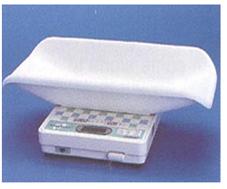
사진 4-66.이런 종류의 저울로 아기의 체중을 재면 몇 온스까지 정확하게 체중을 잴 수 있다.
[소스: Medela]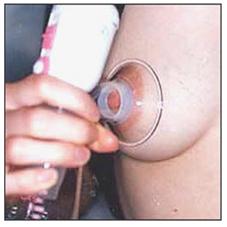
사진 4-67. 유축기로 젖을 짜서 그 양을 재어 모유가 충분히 분비되는지 알아보는 방법
Copyright ⓒ 2011 John Sangwon Lee, MD., FAAP

사진 4-68. 손으로 젖을 짜서 짠 젖의 양을 보고 젖이 충분히 분비되는지 알아보는 방법
Copyright ⓒ 2011 John Sangwon Lee, MD, FAAP
.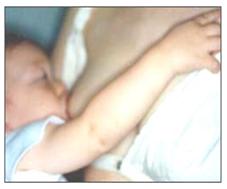
사진 4-69. 모유를 다 빨아먹은 아기가 만족스러워하며 기분 좋게 잘 자고 체중도 정상적으로 증가된다면 모유가 충분히 분비된다고 간주할 수 있다.Copyright ⓒ 2011 John Sangwon Lee, MD., FAAP

사진 4-70. 이렇게 손으로 젖을 짜지 않아도 젖이 줄줄 흘러나오면 모유의 분비가 충분히 분비된다고 단정해도 된다.
Copyright ⓒ 2011 John Sangwon Lee, MD., FAAP
| 젖이 충분히 분비되지 않는다고 의심될 때 Consider insufficient breast milk supply if in the following situations |

사진 4-71. 젖을 충분히 먹지 못하면 아기의 체중은 정상적으로 증가되지 않는다. 예측 체중 백분위선을 따라 체중이 늘지 않을 수도 있다
Copyright ⓒ 2011 John Sangwon Lee, MD., FAAP
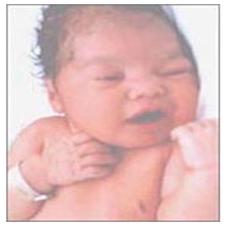
사진 4-72. 모유를 충분히 먹지 못해 배가 고프면 아기는 더 많이 울고 더 보챈다. 잘 자지 않고 자다가 자주 깨기도 한다.Copyright ⓒ 2011 John Sangwon Lee, MD., FAAP
| 다음과 같은 경우 모유가 부족한지 의심해봐야 한다. |
- 아기가 한쪽 유방의 젖을 빨아먹고 있는 동안 다른 쪽 유방에서 젖이 조금도 흘러나오지 않을 때, 즉 렛 다운 징후가 없을 때
- 젖을 먹일 때가 됐는데도 엄마의 유방이 쏘이지도 않고 젖이 흘러나오지도 않을 때
- 매번 젖을 먹일 때마다 양쪽 유방에 괸 젖을 다 먹이는데 총 30~40분 이상 걸릴 때
- 매번 양쪽 유방에 괸 젖을 먹일 때마다 총 30~40분 이상 걸리고 젖을 먹인 후 아기가 배고픈 듯이 젖꼭지를 계속 더 빨면서 젖꼭지에서 입을 빼려고 하지 않을 때
- 젖을 다 먹고 나서도 아기가 잘 자지 않거나, 오랫동안 깨어 있거나, 자주 울고 보챌 때
- 매번 젖 먹이는데 총 30~40분 이상 걸리고 젖을 먹인 후에 잘 잠들어 자지 않거나 자다가 자주 깰 때
- 젖을 먹일 시간이 되지 않았는데도 아기가 자다가 자주 깨거나 울 때, 또는 젖을 먹이면 아기가 몹시 배고픈 듯이 젖을 힘차게 잘 빨아먹을 때
- 소아 건강검진을 정기적으로 받을 때 아기의 체중이 예상했던 체중치 만큼 정상적으로 늘지 않을 때
- 날씨가 매우 더운데 땀을 흘리지도 않고, 또 다른 이상이 없는데도 소변의 양이 정상 이하로 적거나 소변을 보는 간격이 정상 이상으로 길어질 때
- 젖 먹는 아기의 양 볼이 입 안 속으로 빨려 들어가고(양볼 함몰 징후가 있고) 목구멍 속에서 젖을 넘기는 꼴깍꼴깍 소리가 나지 않을 때
- 대변을 3~4일 간격으로 또는 그 보다도 더 오랜 간격을 두고 보거나 변비가 있을 때
- 잰 체중치를 성장차트의 체중 백분위선에 그려 넣었을 때 체중이 과거의 체중 백분위선보다 훨씬 더 낮은 백분위선에 있을 때 (그림1-8 참조)
- 그 외 다른 이유로도 모유가 부족한지 의심해보아야 한다.
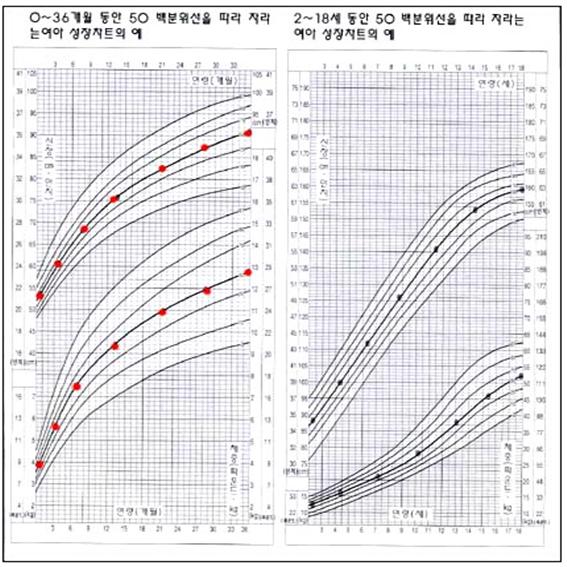
그림 4-23. 아기가 자신의 타고난 성장 속도에 따라 체중이 계속 증가되고 신장도 계속 자라고 있다면 모유를 충분히 먹고 있다고 판단할 수 있다.
(여기서 50 퍼센타일 성장 백분위선을 따라 성장하는 성장차트의 예이다.)
이상원 저. Copyright ⓒ 2011 John Sangwon Lee, MD., FAAP
| 젖이 정말로 부족한 것일까? |
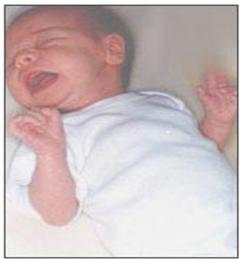
사진 4-73. 젖이 충분히 분비되지 않으면 아기는 배가 고파서 울고 짜증을 낸다. 체중도 정상적으로 늘지 않는다. 1회 수유 시간이 보통 이상으로 길어지고 더 자주 먹는다. 쉽게 잠들지 않고 자다가 잘 깰 수 있다. Copyright ⓒ 2011 John Sangwon Lee, MD., FAAP

사진 4-74. 배가 고프지도 않은데 영아산통으로 이렇게 심하게 운다. 일반적으로 모유를 먹는 아기들에게는 영아산통이 덜 생긴다.
Copyright ⓒ 2011 John Sangwon Lee, MD., FAAP
- 요즘 인공영양을 먹여 아기를 키우는 엄마들보다 엄마의 젖을 먹여 아기를 키우는 엄마들이 나날이 점점 더 늘어나고 있다. 다행스런 일이다.
- 매스컴, 모유수유 참고서, 모유수유 전문가, 모유수유 전문의, 간호사, 모유수유를 성공적으로 끝냈던 선배 등으로부터 모유수유 지식을 얻고 성공적으로 모유수유를 해내는 초보엄마들이 점점 더 늘어나고 있다.
- 그러나 미국의 경우, 분만 후 모유를 열심히 수유했던 엄마들의 50%가 분만 후 6주 이내에 모유수유를 포기하고 인공영양을 먹여 아기 자녀들을 양육하고 있다.
- 그 이유 중 가장 흔한 것이 “엄마의 젖이 부족해서”라는 것이다.
- 실제로 모유가 충분히 분비되지 않아 아기 자녀에게 모유를 먹여 키울 수 없었던 수유모는 아주 드물다. 그런데도 일부의 수유모는 “젖이 충분히 분비되지 않아 아기에게 젖을 충분히 줄 수 없다”고 단정한다. 이런 수유모들의 마음속을 자세히 들여다보면 사실 다음과 같은 걱정을 품고 있을 때가 많다.
- 모유수유로 아기를 키울 자신이 없어서 모유수유 전문가나 모유수유 전문의와 첫 상담을 하기 훨씬 전부터 수유모 혼자서 모유수유를 포기하기로 이미 마음속으로 결정해버렸다.
- 사실상 모유를 옳게 수유하는 방법도 잘 모르고, 아기를 올바르게 보살피고 양육하는 방법도 잘 모른다.
- 모유수유를 성공적으로 잘 할 수 있게 도와줄 수 있는 사람들을 주위에서도 찾기 힘들다.
- 어떤 엄마도 모유수유를 본능적으로 자연적으로 쉽게 잘 할 수 있다고 잘못 알고 있다.
- ‘내 젖은 내 아기에게 맞지 않는다.’라고 잘못 생각한다.
- ‘내 아기는 내 젖을 먹는 것보다 인공영양 먹기를 더 좋아한다.’고 잘못 생각한다.
- ‘인공영양을 먹이기가 젖 먹이기보다 더 쉽다’고 잘못 생각한다.
- ‘인공영양으로 아기를 키우면 아기가 더 잘 성장하고 더 잘 발육될 수 있다’고 잘못 알고 있다.
- ‘모유수유를 하면 유방이 외관상으로 좋지 않게 변화될 것’이라고 잘못 생각한다.
- 사람들 앞에서 모유수유를 하는 것이 부끄럽다고 생각한다.
- 전업 직장생활을 하기 때문에 모유수유를 더 이상 할 수 없다’라고 잘못 생각한다.
- 모유수유를 하기 위해 음식물을 많이 섭취하면 수유모의 체중이 늘어나 비만해질 수 있다고 잘못 생각한다.
- ‘아기가 젖을 빠는 것보다 우유병 꼭지를 빠는 것을 더 좋아하니 인공영양을 주는 것이 낫다’라고 잘못 생각한다.
- 수유모 스스로가 정신적·육체적으로 충분히 휴식을 취하지 못했다.
- 수유모가 정서적으로 불안하다.
- 아기나 산모에게 있는 어떤 병을 약물로 치료 받았다.
- 수유모가 산후 베이비블루나 산후 우울증에 걸려있다.
- 의사도 간호사도 국가도 사회도 모유수유의 중요성을 수요 모에게 잘 교육시키지 안 했을 때.
- 이밖에 다양한 이유로 수유모가 모유수유를 포기하려고 하면 모유의 분비도 점점 줄어들고 젖의 분비가 잘 안 될 수 있다.
| 젖이 충분히 분비되지 않으면 어떻게 하나 What to do when breast milk supply is insufficient |
- 젖을 올바르게 먹이는지 전반적으로 재차 검토한다.
- 아기를 따뜻하게 폭신 싼 후 젖을 먹이기에 가장 적절한 자세로 아기를 엄마의 품에 가까이 끌어다 앉고 유방의 유륜에 아기의 입술을 대고 젖꼭지를 입안에 전부 물려 젖을 올바르게 먹인다.
- 필요에 따라, 젖을 먹이기 전에 따뜻한 물수건으로 유방 찜질을 하고 손으로 유방 전체를 몇 분 동안 마사지해서 모유분비를 더 촉진시키고 젖을 먹이면 젖이 더 쉽게 나오고 더 많이 먹일 수 있다.
- 분만 후 육체적으로 정신적으로 휴식을 충분히 취하고 모유수유를 하기 전후 적절한 육체적 운동을 한다.
- 분만 후 가만히 누워서 육체적 운동을 하지 않고 더 많이 쉬면 모유가 잘 분비 되지도 않고 산후 회복도 더 느리고 또 정신건강에도 좋지 않으며 스트레스가 더 많이 쌓인다.
- 분만으로 생긴 통증은 타이레놀이나 아브프로펜 등 경구용 진통제로 치료 하면 모유가 더 잘 분비 되고 잠이 더 잘 온다.
- 분만 후 자질구레한 가사문제나 그 외 다른 문제로 걱정을 많이 하거나 긴장하거나 스트레스를 많이 받으면 모유가 잘 분비되지 않는다. 이럴 때는 남편의 도움과 다른 사람들의 도움을 받는다.
- 아기의 건강에 어떤 문제가 있다고 걱정하면 소아청소년과 전문의의 도움을 곧 받고 그의 검진을 받는다. 아기의 체중이 정상적으로 늘고 있는지 알아보기 위해 생후 3~4일에 또는 생후 1~2주에 소아청소년과에서 건강검진을 받고 체중을 달아보고 모유수유에 관해 의사나 간호사와 상담한다.
- 분만 후 아기와 산모의 건강상태가 좋으면 분만 후 어느 때든지 모유수유를 시작할 수 있다. 모유의 분비량은 수요 공급 법칙에 의해 분비되고 젖을 더 많이 빨면 유방의 말초 신경이 자극 받아 신경 임펄스가 시상하부로 전달되고 그 다음은 뇌하수체 전엽을 자극해 거기서 프로랙틴이 분비되고, 또 뇌하수체 후엽을 자극해 거기서 옥시토신(피토신)이 분비되고 그 두 호르몬의 영향을 받아 유방 내 젖 분비 세포가 자극받아 젖 생산이 촉진되고 젖 분비 관계가 수축되기 때문에 젖이 분비된다.
- 빈 젖이라도 분만 후 첫 날부터 매 1.5~2시간마다 빨린다. 분만 후 첫 날에는 한 번 젖 주는데 한쪽의 젖을 3~4분 동안 빨게 하고 그 다음에는 엄마의 손가락으로 아기의 입을 살짝 밀어서 아기의 입을 벌리고 아기 입에서 젖꼭지를 뺀 후 다른 쪽 유방에 괸 젖을 3~4분 동안 더 먹이는 식으로 1회 모유수유로 끝낸다.
- 분만 다음 날부터 분만 후 3~4일까지 한 번에 한쪽 유방에 괸 젖을 약 10분간, 양쪽 유방에 괸 젖을 총 20분 정도 걸려 먹인다.
- 그 후부터 한 번 젖 먹이는 총 시간을 점점 더 늘린다. 분만 3~4일 이후부터 약 15~20분 동안 한쪽 유방에 괸 젖을 먹이고 양쪽 유방에 괸 젖을 다 먹이는데 총 30~40분 걸려 먹이고 그 다음은 매 2~3시간 간격으로 하루 총 8~12번 수유한다.
- 수유모는 균형 잡힌 영양분이 든 음식물을 충분히 섭취하고 수분을 적어도 1일 2,000cc 이상섭취하고 수유모는 수유를 않는 평소 보다 1일 약 500칼로리 정도 더 음식물을 더 섭취한다.
- 때로는 엄마의 젖이 충분히 분비되지만 젖 먹는 아기가 아프거나 다른 이유로 젖을 충분히 빨아먹지 못할 수 있다. 이럴 때는 소아청소년과 의사에 문의해서 아기에게 어떤 이상이 있나 검진해주고 모유가 계속 잘 먹도록 조치를 곧 취한다.
- 모유수유를 성공적으로 했던 경험 있는 이웃 여성들이나 언니들, 간호사나 라 레췌 리그 요원들, 또는 소아청소년과 전문의나 모유수유 전문가 또는 모유수유 전문의에게 문의해서 모유를 올바르게 수유하는 방법을 배우고 모유수유 참고서를 이용해서 모유수유를 잘 할 수 있는 정보를 얻어 모유수유를 옳게 한다.
- 때로는 어떤 수유모는 모유수유를 산후 며칠 내지 몇 주 동안 열심히 하다가 모유수유를 더 이상하지 않겠다고 마음먹고 모유수유를 포기하기도 한다.
- 모유로 아기를 양육하겠다는 확고히 결정을 내리지 못한 수유모들 중 일부는 모유수유 대신 인공영양을 먹여 아기를 양육해도 괜찮다고 생각한다. 이런 경우 모유수유를 일찍 감치 중단하고 인공영양을 먹이는 경향이 있다.
- 의사의 지시도 없이 엄마의 젖을 먹이는 대신 인공영양을 먹이거나 모유도 먹이고 보충용 인공영양도 먹이는 소위 “혼합수유”를 엄마의 마음대로 그때그때 하기도 한다.
- 모유수유 이외 보충용 인공영양, 물, 5%경구용 포도당액을 의사의 지시 없이는 먹이지 않는다.
- 내 아기를 나의 젖으로 키우겠다는 엄마의 마음가짐이 젖을 잘 나오게 하는 가장 중요한 요인 중 하나이다.
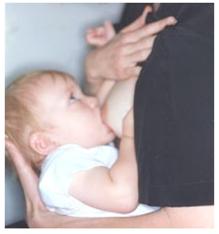
사진 4-74. 아기의 입안에 젖꼭지가 잘 들어가 있게 하고 젖꼭지를 잘 빨 수 있게 아기를 엄마 품에 가까이 안고 젖을 먹여야 한다. 모유수유 중 엄마로부터 눈길 접촉사랑, 신체 접촉사랑을 통해 아기의 사랑 탱크가 채워진다. Copyright ⓒ 2011 John Sangwon Lee, MD., FAAP
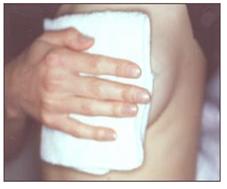
사진 4-75. 따뜻한 물수건으로 유방을 더운찜질을 하고 손으로 유방 마사지를 하면 젖이 더 잘 분비될 수 있다. Copyright ⓒ 2011 John Sangwon Lee, MD., FAAP
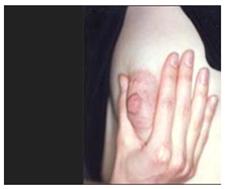
사진 4-76. 젖을 먹이기 전에 손으로 유방을 마사지한다. 프로랙틴과 피토신 호르몬의 영향으로 젖이 더 많이 분비될 수 있다. Copyright ⓒ 2011 John Sangwon Lee, MD., FAAP

사진 4-77. 젖이 충분히 분비되지 않으면 주사기와 비슷하게 생긴 튜브 속에 인공영양이나 짠 모유를 넣고 그 튜브에 연결된 세관의 한쪽 끝 부분을 엄마의 젖꼭지에 부착시킨다. 그 다음 아기가 엄마의 젖꼭지를 빨아 젖을 먹을 때 젖꼭지에 부착 시킨 세관 끝 부분도 동시 빨게 된다. 이때 그 튜브 속이 있는 인공영양이나 모유도 엄마의 젖꼭지에서 나오는 젖과 동시에 빨아 먹게 된다. 튜브 속에 인공영양을 넣어 먹게 하는 대신 미리 짜놓은 모유를 넣어 이미 짠 모유와 유방에서 나오는 젖을 동시 빨아 먹일 수 있다. Copyright ⓒ 2011 John Sangwon Lee, MD., FAAP
| 미국 모유수유 장려와 모유수유 현주소 |
2010년 4월 5일 미국 소아청소년과 학회 모유수유 권장
|
| 온갖 노력을 다 해도 젖이 부족할 때 Insufficient breast milk supply with every efforts |
- 분만 후 첫 1~3일 동안에는 거의 초유만 나오고 변이) 모유와 성숙 모유는 분비되지 않는다.
- 이 때 초유만 조금 분비되고 변이 모유나 성숙 모유가 분비되지 않더라고 엄마의 젖꼭지를 빨린다.
- 수유모는 1회 모유수유에 한 쪽 젖을 3~4분 동안, 양쪽 젖을 6~8분 동안 빨리고 매 1~2시간마다 혹은 3시간 마다 아기에게 빨린다.
- 모유 분비량은 수요공급 법칙에 따라 좌우된다.
- 초유가 조금 분비되고 변이 모유와 성숙 모유가 분비되지 않는데도 아기가 젖꼭지를 빨 때 프로랙틴, 옥시토신(피토신)이 뇌하수체에서 분비된다.
- 프로랙틴으로 인해 젖샘세포가 자극받아 젖이 생성된다. 근 상피세포와 젖 분비관계가 옥시토신(피토신)의 자극을 받아 젖이 젖꼭지 구멍으로 분비된다.
- 따라서 빈 젖을 빨 때, 이런 호르몬의 분비가 증진되고 젖이 더 잘 생성되고 더 분비될 수 있다. 분만 후 초유만 나오는 동안이라도 빈 젖 젖꼭지를 빨게 하는 것이 중요한다.
- 빈 젖이라도 빨리면 유방에 있는 신경이 자극 받아 젖을 분비하는 데 관련된 프로랙틴 호르몬이 나오고 그로인해 결국 젖세포(포상샘세포)가 자극받아 젖이 유방에서 생성되기 때문이다.
- 간호사나 소아청소년과 의사도 모유를 수유하는 산모들에게 모유 이외 신생아 경구용 5% 포도당 물, 인공영양, 신생아용 무균 식수를 보충용으로 먹이는 것도 장려하지 않는다.
- 분만 후 젖이 안 나온다고 신생아용 경구용 5% 포도당 물, 인공영양, 신생아용 멸균 식수를 젖을 먹는 아기에게 보충용으로 먹이면 신생아가 엄마 젖꼭지를 덜 빨게 되고 따라서 유방이 덜 자극받게 되고 프로랙틴이 적게 분비되어 모유의 분비가 잘되지 않고 결과적으로 아기가 모유를 충분히 먹지 못하게 된다.
- 때로는, 모유수유를 하려고 아무리 노력해도 모유가 충분히 분비되지 않아 모유수유를 더 이상 계속할 수 없는 일도 생긴다.
- 따라서 특별한 경우, 의사의 처방이 있을 때만 갓난아기나 신생아에게 응급 보충용 인공영양이나 그 외 다른 신생아용 음식물을 먹이는 것이 좋다.
- 특별한 경우, 한두 번에 한해 갓난아기나 신생아에게 먹일 수 있는 응급용 인공영양이라든지 5% 포도당액 등을 ‘보충용 인공영양’이라고 부르고 싶다.
- 이런 식으로 신생아에게 먹이는 피딩 방법을 ‘혼합수유’라고 부르고 싶지 않다.
- 특히 초보 엄마들은 혼합수유가 소아청소년과에서 일반적으로 장려 하는 모유수유 방법의 하나인 줄로 잘 못 알고 있다.
- 생후 약 8주 동안 아기가 젖을 먹고 싶은 것 같든지, 배가 고파서 울면 2~3시간마다 모유수유를 하는 것이 보통이다.
- 엄마가 젖을 옳게 먹인 후 젖이 충분히 분비되지 않아 아기가 배고픈 것 같으면 인공영양을 보충용으로 먹일 수 있다고 주장하는 부모들도 있고 의사들도 있다.
- 그러나 부족한 모유를 보충하기 위해 인공영양을 보충용으로 먹이기 전에 왜 엄마의 젖이 충분히 분비되지 않는지, 왜 아기가 젖을 충분히 먹지 못하는지 그 이유를 알아보고 그 이유에 따라 모유수유를 옳은 방법으로 수유해야 한다. 그리고 가능한 한 인공영양을 보충용으로 먹이지 말아야 한다.
- 분만 후 3~4일 이후부터는 대부분의 수유모의 유방에서 전이 모유와 성숙 모유가 분비되기 시작한다.
- 수유모의 유방이 충만해지면 거의 모든 아기가 엄마의 젖만 먹어도 만족한다. 이때도 인공영양이나 포도당물 등 인공영양을 보충적으로 먹이지 말고 모유만 수유해야 한다.
- 때로는 병원 산실에서 퇴원할 때 수유모에게 인공영양 등 신생이 양육용 선물 보따리를 인공영양제조 회사에서 주기도 한다.
- 이런 선전용 선물 보따리 속에 든 인공영양을 버리기가 아깝다고 모유 대신 아기에게 인공영양을 보충용으로 먹이는 경우가 있다.
- 이 때문에 미국 병원 신생아실에서는 선전용 인공영양 보따리를 더 이상 보관하지도 말고 그 선물 보따리를 집으로 가지고 가지 말라는 모유수유 전문가들도 있다.
- 미국 소아청소년과 학회에서도 이런 선물용 보따리를 산모에게 주지 말라고 경고하고 있다.
- 수유모들은 분만 후 병원에서 퇴원해 집에 왔을 때 밀린 집안일과 그 외 다른 일들로 산후에 스트레스를 많이 받는다.
- 더러는 산후 블루 내지 산후 우울증에 걸리기도 한다.
- 어떤 산모는 아기 건강에 대해 쓸데없이 많이 걱정 하고 쉽게 피로하기도 하고 긴장할 수 있다. 아기가 조금만 울어도 어디가 아파서 우는 줄로 잘못 알고 많이 걱정하기도 한다.
- 이처럼 수유모가 많이 긴장하거나 과도하게 걱정하면 젖이 잘 분비되지 않는다.
- 그러면 아기는 젖을 충분히 먹지 못해 더 자주 운다.
- 아기가 자주 울고 보채면 수유모는 한층 더 걱정 하게 된다.
- 결국 이런 악순환이 반복되어 젖이 잘 분비되지 않게 된다.
- 이런 때는 서슴지 말고 아기 아빠와 대화를 더 하고 때로는 친구, 의사 등의 도움을 청하는 것이 좋다.
- 때로는 분만 후 베이비 블루나 산후 우울증이 생겨 모유수유를 잘 할 수 없다,
- “젖 먹는 아기에게 모유 이외 다른 음식물을 먹이지 말라”고 의사가 간호사가 경고 했지만 위에서 설명한 경우에는 하루 중 밤이나 낮 적당한 시간을 골라 모유를 먹이는 대신 ‘보충용 인공영양’을 한두 번 먹일 수 있다.
- 이렇게 먹이는 인공영양은 부족한 것을 응급으로 보충하는 목적으로만 먹여야 한다. 여기서 한번 잘못하면 모유수유를 더 이상 계속 할 수 없는 처지가 될 수 있다.
- 의사의 지시에 따라 인공영양을 보충용으로 먹이도록 신신당부하는 것도 그 때문이다.
- 수유모가 아기에게 젖을 먹일 시간에 아빠나 집안 식구 중 한 사람이 엄마 대신 인공영양을 보충용으로 한두 번 정도 아기에게 먹일 수 있다.
- 이때 수유모는 정신적·육체적으로 잠시 동안이라도 충분한 휴식을 취해 피로를 회복한 다음 다시 모유수유를 시작하는 것이 좋다.
- 이렇게 수유 하면 젖이 충분히 잘 나올 수 있다.
- 그러나 인공영양을 응급 보충용으로 먹이는 방법을 너무 자주 또는 오랫동안 계속 쓰면 안 된다. 어떤 아기는 엄마의 젖을 더 이상 먹지 않고 보충용 인공영양만 계속 먹으려고 해서 결국에는 모유수유를 포기하는 경우도 있고 때로는 모유수유도 하고 인공영양도 먹이는 소위 ‘혼합수유’를 하는 경우도 생기 때문이다.
- 생후 4개월 이후 이유를 시작할 때 젖이 부족하면 젖을 먹인 직후에 인공영양을 먹이는 방법이나, 젖을 먹여야 할 시간에 젖을 먹이는 대신 인공영양을 한두 번 정도 먹이는 방법도 있다.
- 이것은 일종의 이유하는 방법이다.
- 젖이 진짜로 부족할 때는 의사의 지시에 따라 모유수유를 계속하면서 쌀로 만든 영아용 시리얼 류 고형식을 짠 젖이나 인공영양 또는 물에 개서 먹일 수 있다.
- 이것도 일종의 이유의 시작이다.
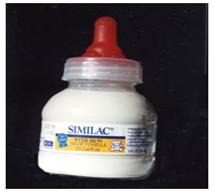
사진 4-78. 온갖 노력을 다 해봐도 젖이 분비되지 않을 때가 있다. 이럴 때 먹일 수 있는 인공영양을 ‘구조적 인공영양 공급’, 또는 ‘보충용 인공영양 공급’이라 한다. 구조적 인공영양 공급은 한두 번 정도에 한해 응급 보충용으로만 먹인다. 계속 먹이면 모유수유를 더 이상 하지 못할 때가 많다. Copyright ⓒ 2011 John Sangwon Lee, MD.,FAAP
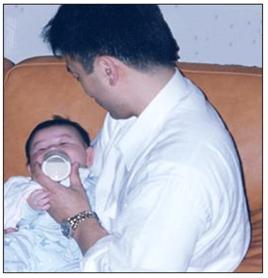
사진 4-79. 아빠나 집안 식구 중 한 사람이 아기에게 “구조적 인공영양(보충용 인공영양)”을 하루 한두 번 먹일 수 있다. 이때 먹이는 인공영양은 부족한 젖을 보충하기 위한 구조적 인공영양으로 그쳐야 한다.Copyright ⓒ 2011 John Sangwon Lee, MD., FAAP
| 나이와 체중에 맞는 1일 권장 영양분 섭취량 |
| 나이 | 성별 | 체중 kg | 단백 질 g | 비타민 RE | 비타민 ㎍ | 비타민 mg | 비타민 mg | 엽산 ㎍ | 비타민 B₁₂ ㎍ | 칼슘 mg | 인 mg | 마그네슘 mg | 철 mg | 옥 소 mg | 아 연 mg |
| 개월 | |||||||||||||||
| 0-4 | 같음 | 6.0 | 12 | 400 | 10 | 3 | 20 | 25 | 0.3 | 250 | 150 | 20 | 0.3 | 30 | 2 |
| 5-12 | 같음 | 9.0 | 12 | 400 | 10 | 3 | 20 | 40 | 0.4 | 400 | 200 | 32 | 7 | 40 | 3 |
| 년 | |||||||||||||||
| 1 | 같음 | 11 | 13 | 400 | 10 | 3 | 20 | 40 | 0.5 | 500 | 300 | 40 | 6 | 55 | 4 |
| 2-3 | 같음 | 14 | 16 | 400 | 5 | 4 | 20 | 50 | 0.6 | 550 | 350 | 50 | 6 | 65 | 4 |
| 4-6 | 같음 | 18 | 19 | 500 | 5 | 5 | 25 | 70 | 0.8 | 600 | 400 | 65 | 8 | 85 | 5 |
| 7-9 | 남자 | 25 | 26 | 700 | 2.5 | 7 | 25 | 90 | 1.0 | 700 | 500 | 100 | 8 | 110 | 7 |
| 여자 | 25 | 26 | 700 | 2.5 | 6 | 25 | 90 | 1.0 | 700 | 500 | 100 | 8 | 95 | 7 | |
| 10-12 | 남자 | 34 | 34 | 800 | 2.5 | 8 | 25 | 120 | 1.0 | 900 | 700 | 130 | 8 | 125 | 9 |
| 여자 | 36 | 36 | 800 | 2.5 | 7 | 25 | 130 | 1.0 | 1100 | 800 | 135 | 8 | 110 | 9 | |
| 13-15 | 남자 | 50 | 49 | 900 | 2.5 | 9 | 30 | 175 | 1.0 | 1100 | 900 | 185 | 10 | 160 | 12 |
| 여자 | 48 | 46 | 800 | 2.5 | 7 | 30 | 170 | 1.0 | 1000 | 850 | 180 | 13 | 160 | 9 | |
| 16-18 | 남자 | 62 | 58 | 1000 | 2.5 | 10 | 40 | 220 | 1.0 | 900 | 1000 | 230 | 10 | 160 | 12 |
| 여자 | 53 | 47 | 800 | 2.5 | 7 | 30 | 190 | 1.0 | 700 | 850 | 200 | 12 | 160 | 9 | |
| 19-24 | 남자 | 71 | 61 | 1000 | 2.5 | 10 | 40 | 220 | 1.0 | 800 | 1000 | 240 | 9 | 160 | 12 |
| 여자 | 58 | 50 | 800 | 2.5 | 7 | 30 | 180 | 1.0 | 700 | 850 | 200 | 13 | 160 | 9 | |
| 25-49 | 남자 | 74 | 64 | 1000 | 2.5 | 9 | 40 | 230 | 1.0 | 800 | 1000 | 250 | 9 | 160 | 12 |
| 여자 | 59 | 51 | 800 | 2.5 | 6 | 30 | 185 | 1.0 | 700 | 850 | 200 | 13 | 160 | 9 | |
| 50-74 | 남자 | 73 | 63 | 1000 | 5 | 7 | 40 | 230 | 1.0 | 800 | 1000 | 250 | 9 | 160 | 12 |
| 여자 | 63 | 54 | 800 | 5 | 6 | 30 | 195 | 1.0 | 800 | 850 | 210 | 8 | 160 | 9 | |
| 75+ | 남자 | 69 | 59 | 1000 | 5 | 6 | 40 | 215 | 1.0 | 800 | 1000 | 230 | 9 | 160 | 12 |
| 여자 | 64 | 55 | 800 | 5 | 5 | 30 | 200 | 1.0 | 800 | 850 | 210 | 8 | 160 | 9 | |
| 첨가 | |||||||||||||||
| 임신첫째 3개월간 | 5 | 0 | 2.5 | 2 | 0 | 200 | 0.2 | 500 | 200 | 15 | 0 | 25 | 6 | ||
| 임신둘째 3개월간 | 15 | 0 | 2.5 | 2 | 10 | 200 | 0.2 | 500 | 200 | 45 | 5 | 25 | 6 | ||
| 임신셋째 3개월간 | 24 | 0 | 2.5 | 2 | 10 | 200 | 0.2 | 500 | 200 | 45 | 10 | 25 | 6 | ||
| 모유(첨가) | 22 | 400 | 2.5 | 3 | 25 | 100 | 0.2 | 500 | 200 | 65 | 0 | 50 | 6 | ||
표 나이에 따른 1일 권장 칼로리, 비타민, 그 외 다른 영양분 용량
| 나이 | 성별 | 에너지 Kcal | 티아민 mg | 리보플라민 mg | 나이아신 NE | 고도 불포화 지방산 g | 고도 불포화 지방산 g |
| 개월 | |||||||
| 0-4 | 같음 | 600 | 0.3 | 0.3 | 4 | 0.5 | 3 |
| 5-12 | 같음 | 900 | 0.4 | 0.5 | 7 | 0.5 | 3 |
| 년 | |||||||
| 1 | 같음 | 1100 | 0.5 | 0.6 | 8 | 0.6 | 4 |
| 2-3 | 같음 | 1300 | 0.6 | 0.7 | 9 | 0.7 | 4 |
| 4-6 | 같음 | 1800 | 0.7 | 0.9 | 13 | 1.0 | 6 |
| 7-9 | 남자 | 2200 | 0.9 | 1.1 | 16 | 1.2 | 7 |
| 여자 | 1900 | 0.8 | 1.0 | 14 | 1.0 | 6 | |
| 10-12 | 남자 | 2500 | 1.0 | 1.3 | 18 | 1.4 | 8 |
| 여자 | 2200 | 0.9 | 1.1 | 16 | 1.2 | 7 | |
| 13-15 | 남자 | 2800 | 1.1 | 1.4 | 20 | 1.5 | 9 |
| 여자 | 2200 | 0.9 | 1.1 | 16 | 1.2 | 7 | |
| 16-18 | 남자 | 3200 | 1.3 | 1.6 | 23 | 1.8 | 11 |
| 여자 | 2100 | 0.8 | 1.1 | 15 | 1.2 | 7 | |
| 19-24 | 남자 | 3000 | 1.2 | 1.5 | 22 | 1.6 | 10 |
| 여자 | 2100 | 0.8 | 1.1 | 15 | 1.2 | 7 | |
| 25-49 | 남자 | 2700 | 1.1 | 1.4 | 19 | 1.5 | 9 |
| 여자 | 1900 | 0.8 | 1.0 | 14 | 1.1 | 7 | |
| 50-74 | 남자 | 2300 | 0.9 | 1.2 | 16 | 1.3 | 8 |
| 여자 | 1800 | 0.8 | 1.0 | 14 | 1.1 | 7 | |
| 75+ | 남자 | 2000 | 0.8 | 1.0 | 14 | 1.1 | 7 |
| 여자 | 1700 | 0.8 | 1.0 | 14 | 1.1 | 7 | |
| 임신 | |||||||
| 임신 첫째 3개월간 | 100 | 0.1 | 0.1 | 1 | 0.05 | 0.3 | |
| 임신 둘째 3개월간 | 300 | 0.1 | 0.3 | 2 | 0.16 | 0.9 | |
| 임신 셋째 3개월간 | 300 | 0.1 | 0.3 | 2 | 0.16 | 0.9 | |
| 모유 | 450 | 0.2 | 0.4 | 3 | 0.25 | 1.5 | |
소스: From Minister of supply and services Canada.
Nutrition Recommendations for Canadians: The Report of the Scientific Review Committee. Ottawa, Canada: Supply and Services Canada;1990]
| 한국 신생아들의 체중과 신장의 성장차트와 백분위 수 Weight and height charts and percentile of Korean newborn infants |
- 자녀들을 키우는 동안 성장하고 있는 어린 자녀가 너무 크다, 또는 너무 작다고 걱정하는 부모들도 있다.
- 그런 걱정을 하기 전에 자녀의 체중과 신장을 재고 그 체중과 신장 수치를 성장차트에 그려 본다. 자녀의 체중과 신장이 성장 차트 백분위수선 중 어느 백분위수선에 속해있는지 알아보면 자녀의 성장 패턴을 쉽게 이해할 수 있다. 보다 과학적으로 자녀의 성장에 대해 이해하는 방법이다.
- 예를 들어 갓 태어난 남 신생아의 출생 시 체중이 2.6㎏라고 할 때 그 신생아의 체중을 성장차트의 체중 백분위선에 그려보면 아기의 체중이 3 백분위수(3 퍼센타일)에 속하는 것을 알 수 있다.
- ‘갓 태어난 남 신생아아의 체중이 3 백분위수에 속한다.’는 말을 풀어 설명하면 통계학적으로 그 신생아의 나이, 성별, 종족과 같은 갓 태어난 남 신생아 100명 중 2명 신생아들의 체중은 그 신생아의 출생 시 체중 2.6㎏ 보다 더 가볍고, 100명 중 97명의 신생아들의 출생 시 체중은 그 신생아의 출생 시 체중 2.6㎏보다 더 무겁다는 뜻이다.
- 또 다른 예를 들어 설명하면 갓 태어난 어떤 남 신생아의 출생 시 체중이 4.1㎏일 때 그 신생아의 체중을 성장차트의 백분위선에 그려보면 그 신생아의 출생 시 체중은 97 백분위수선에 속한다는 것을 알 수 있고, 같은 나이의 또래들 중 어느 정도로 체중이 무거운지 쉽게 알 수 있다.
- 이 신생 남아와 나이, 성별, 종족이 같은 갓 태어난 신생 남아 100명 중 3명의 신생아들의 출생 시 체중은 이 신생 남아의 출생 시 체중 4.1㎏ 보다 더 무겁고 96명의 신생 남아들의 출생 시 체중은 이 신생 남아의 출생 시 체중 4.1㎏보다 더 가볍다는 것을 뜻한다. 그래서 같은 나이 또래 들 중 어느 정도로 체중이 더 무거운지 또 더 가벼운지 쉽게 알 수 있다.
- 각 아이의 성장발육 속도는 유전, 체질, 환경 등 여러 조건에 따라 다를 수 있다.
- 내 아이의 체중, 신장의 성장발육의 정도를 같은 종족, 같은 성별인 동년배 아이들의 그것과 비교하는 것보다, 내 아이 자신의 체중과 신장이 내 아이 본인의 성장차트의 체중 백분위선 또는 신장 백분위선에 따라 정상적으로 자라고 있는지 알아보는 것이 더 중요하다.
- 다시 설명하면 다른 아이의 성장과 내 아이의 성장을 비교해볼 수 있지만 내 아이의 성장이 내 아이의 성장 차트의 백분위선을 따라 계속 자라는지 알아보는 것이 더 의미가 있다.
- 어떤 아이의 체중과 신장이 그 아이의 성장차트의 백분위선에 따라 전과 거의 같게 계속 늘어 가면 그 아이는 정상적으로 성장하고 있다고 볼 수 있다.
- 이 경우 모유의 분비량도 적절하고, 아기가 모유도 적절히 먹고 있다는 것을 간접적으로 알 수 있다.
- 아이의 체중 치와 신장 치를 성장차트에 그렸을 때는 그 아이의 전 체중 백분위선과 신장 백분위선을 따라 계속 자라지 않고 그 백분위선 보다 조금 더 위에 있는 성장 백분위선을 따라, 또는 조금 아래에 있는 성장 백분위선을 따라 자라는 것은 보통으로 있는 성장 패턴으로 간주하는 것이 마땅하다.
- 그러나 아이의 체중과 신장이 전 체중 백분위선과 전 신장 백분위선을 따라 계속 자라지 않고 그 동안 체중 백분위선이나 신장 백분위선보다 훨씬 위에 있는 백분위선이나, 또는 그 아래 훨씬 많이 떨어져 있는 백분위선을 따라 자라든지, 몇 달 또는 몇 년 후에 잰 체중치나 신장치를 체중 백분위수선과 신장의 백분위수선에 그렸을 때 전 백분위수선이나 그와 비슷한 백분위선을 계속 따라 자라지 않으면 그 아이의 성장에 어떤 이상이 있는지 알아보아야 한다.
- 성장차트를 이용해서 각 아이의 예측 체중과 신장 증가치를 알아 볼 수 있고 다음 표에 있는 소아 청소년(0-18세)의 예측 체중, 신장 계산 공식에 의해서도 알아 볼 수 있다.
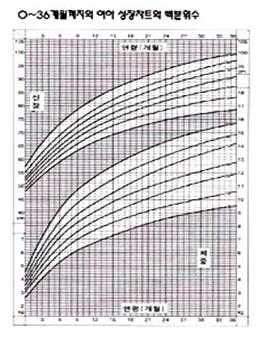
그림 4-24. 0∼3세 한국 여아들의 성장차트와 백분위선
소스: 부모도 반의사가 되어야 한다―소아가정간호백과. “이상원 저”
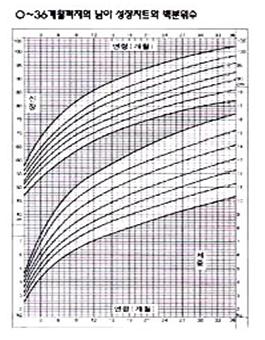
그림 4-25. 0∼3세 한국 남아들의 성장차트와 백분위선
소스: 부모도 반의사가 되어야 한다-소아가정간호백과. “이상원 저”
|
|
|
|
The amount of milk produced is governed by the laws of natural supply and demand. 모유 분비량은 자연 수요공급 법칙에 따라 좌우된다.
Amount of breast milk secretion is upon laws of supply and demand
• The amount of milk produced is influenced by a number of conditions, but the amount of milk produced is mainly determined according to the law of supply and demand.
• To ensure that sufficient amounts of breast milk continue to be produced, it is best to have the baby suckle mom’s nipple as soon as possible after delivery.
• Do not feed the newborn with any other food for newborns other than breast milk, such as artificial nutrition, water, and glucose water.
• When the newborn sucks on as much milk as he baby needs, his mother’s milk is released as much as it needs. The more milk the baby is trying to feed on, the more milk will be produced naturally. For this reason, it can be said that the amount of secretion of breast milk is determined by the law of supply and demand’.
• For example, feeding a nursing baby a lot of drinking water instead of breast milk does not create a thirst for something to drink. Eventually, the baby will eat less breastb milk, and the amount of milk produced will naturally decrease.
• If you feed a breastfeeding baby with additional supplementary foods such as formula or artificial nutrition other than milk, there will be no more nutrients and calories to consume at that time because the water, calories, and nutrients the baby needs have already been ingested from supplementary foods such as artificial nutrition.
• So there is no need to breastfeed. Because there is no need to eat more breast milk, breast milk demand is reduced and less milk is produced without sucking. As a result, the amount of milk produced will naturally decrease.
• These easily understandable laws of supply and demand determine the amount of breastfeeding and the amount of milk produced.
• When mixed lactation is fed with breast milk and artificial nutrition, the amount of demand for breast milk decreases and the amount of secretion of breast milk decreases as much as the amount of supplementary artificial nutrition consumed other than breast milk. Therefore, problems can arise in successfully breastfeeding. Another important thing is that both babies and mothers are contrary to the natural principles of breastfeeding about when, how much breastfeeding, and when and how much to breastfeed, and mixed feeding eventually becomes “confusing feeding”.
• During the 3-4 weeks of life, newborns breastfeed 8-12 times a day. In particular, if you need to feed supplementary foods such as artificial nutrition, water, glucose, etc. other than breast milk during this period, it would be good to consult a doctor before deciding to feed.
• For reference, even during the first 1-3 days after delivery, even if a newborn baby sucks milk every 1-2 hours, colostrum is mainly secreted, and mature breast milk is not secreted.

Photo 4-64. Breastfeeding mother’s nipples and nipple rings. Copyright ⓒ 2011 John Sangwon Lee, MD., FAAP
Mixed feeding can be “confused feeding”.
How do you know if you have enough or insufficient breast milk?
How to know the breast milk supply is sufficient or insufficient?

Photo 4-65. You can also weigh your breastfed baby at daily intervals or before or after feeding to see if your baby is consuming enough milk. Copyright ⓒ 2011 John Sangwon Lee, MD., FAAP
• Regardless of the size of the breast, a nursing mother’s breast can provide enough milk for a developing baby.
• In other words, enough milk is produced for the baby to eat and grow, whether large or small. By giving birth to twin babies, you can produce enough milk to raise two babies at once.
• However, most of the nursing mothers always wonder if “I am getting enough milk and if my baby is getting enough milk”.
• There is no simple and accurate way to know if you are getting enough breast milk.
• However, you can indirectly find out if your baby is getting enough breast milk in the following ways.
• First, you can weigh your baby to see if he or she is getting enough breast milk.
• However, the baby’s weight fluctuates every few times during the day.
There is also a difference in the weight measured before and after the urine or feces, and the weight measured before and after breastfeeding depends on the amount of breast milk consumed at that time.
• Therefore, the difference between the baby’s weight immediately before feeding the baby and the baby’s weight immediately after feeding the baby can indirectly determine how much milk has been secreted and how much milk the baby has.
• You can weigh your baby several times a day or at intervals of a day or two to estimate whether the milk is sufficient or insufficient due to an increase or decrease in weight.
• However, it is not always possible to know exactly whether enough milk is produced in this way and whether the baby is getting enough milk.
• It is difficult to find a scale that can measure the change in weight, even as small as 50-100g, and even if it does, the process of calculating the difference in weight in detail is not easy and stressful.
• Babies can also say that their weight gained or decreased by 50-200g before and after urinating or stooling. There may be limitations in determining whether breast milk is secreted sufficiently by increasing or decreasing a baby’s weight.
• After all, this method is also not very practical.
• A nursing mother can determine how much milk is produced by expressing her own milk by hand or with a pump.
However, there will be a lot of difference between the amount of milk a mother squeezed by hand with a breast pump and the amount of milk a baby can suck directly with her mother’s nipples.
After all, I am not sure how to do this either.
If so, how to indirectly find out whether the mother is secreting enough milk and whether the baby is eating enough breast milk by synthesizing the various signs that the baby has.
You may think that breast milk is secreted sufficiently in the following cases:
① Whenever a child undergoes regular health check-ups, it is possible to find out whether the baby’s breastfeeding weight continues to increase normally along with the baby’s past growth percentile, and whether the mother’s milk is sufficiently secreted and the baby is getting enough milk. Most newborns and infants gain 15 to 20 grams of body weight per day by 4 to 5 months of age. In this way, it can be seen indirectly that when the baby’s weight is gained, the mother’s milk is sufficiently secreted.
② When breastfeeding every 2 hours or every 3 to 4 hours, a gulping sound is heard in the baby’s throat.
③ When breastfeeding, the baby’s cheeks do not get sucked into the mouth (no signs of depression of both cheeks)
④ It does not take more than 20 to 30 minutes to feed once,
⑤ Babies fall asleep easily or play well after feeding
⑥ No matter who sees, it grows quickly and gains weight, and develops normally according to age.
⑦ urinate at least 6 to 9 times a day
⑧ Report stool 2 to 5 times a day (however, even a healthy baby who has enough breast milk may stool normally every 2 to 3 days)
⑨ If you breastfeed enough 8 to 12 times a day, you can indirectly know that the mother’s milk secretion is sufficient and the baby is getting enough breast milk.
However, just because the amount or frequency of urine of a breastfed baby is a little small, it should not necessarily be concluded that breastmilk is not secreted enough or that the baby does not eat enough breastmilk.
This is because the amount and frequency of urine is not determined only by the amount of breast milk the baby eats. Whether the room temperature is too high, your baby is sweating more than usual, or the baby who is getting enough milk can urinate a little or less for other reasons.
For that reason, it cannot be concluded that the mother’s milk is not sufficiently produced based on the amount of urine of the breastfeeding baby or the number of times the baby is pressed to urinate.
⑩ When it comes time to breastfeed a baby, there are some nursing mothers whose breasts naturally flow out so that the breasts are swollen and the bras are wet. In addition, some nursing mothers show “let down signs” of milk flowing out of the other breast when feeding their baby from one breast. In this case, you can see that the breast milk is secreted sufficiently.
• In this case, breastfeeding with adequate feeding intervals and proper feeding times allows the baby to get enough milk. (Parents should also be at least the half -doctors ― Encyclopedia of Child and Adolescent Family Nursing-Vol. 14 Child and Adolescent Endocrine, Genetic, Chromosome, Metabolism, Rare Diseases-Growth Chart, Vol. 3 Newborns, Infants, School Age dk, Adolescent Growth, Development, Parenting-Percentile Numbers, growth charts and percentiles)

Photo 4-66: Weighing a baby with this type of scale can accurately weigh up to a few ounces. [Source: Medela]

Photo 4-67. How to express and measure the amount with a breast pump to see if there is enough milk. Copyright ⓒ 2011 John Sangwon Lee, MD., FAAP

Photo 4-68. How to see how much milk you express by hand to see if you are producing enough milk. Copyright ⓒ 2011 John Sangwon Lee, MD, FAAP.

Photo 4-69. If a baby who has sucked all of her milk is satisfied, sleeps comfortably, and gains weight normally, it can be considered that the milk is secreted sufficiently. Copyright ⓒ 2011 John Sangwon Lee, MD., FAAP

Photo 4-70. Even if you don’t express your milk by hand, it can be concluded that if the milk flows out, the secretion of breast milk is sufficiently secreted. Copyright ⓒ 2011 John Sangwon Lee, MD., FAAP
When you suspect that you are not secreting enough milk, consider insufficient breast milk supply if in the following situations

Photo 4-71. If you don’t get enough milk, your baby won’t gain weight normally. Your baby may not gain weight along with the predicted weight percentile. Copyright ⓒ 2011 John Sangwon Lee, MD., FAAP

Photo 4-72. If the baby is hungry for not getting enough breast milk, the baby will cry more and feel more hungry. They don’t sleep well and often wake up after sleeping. Copyright ⓒ 2011 John Sangwon Lee, MD., FAAP
You should be suspicious of a lack of breast milk in the following cases:
- When the baby is sucking milk from one breast and no milk is flowing from the other breast, i.e. there are no signs of let-down When it is time to breastfeed, but the mother’s breast is not stung and the milk does not flow out
- When it takes 30-40 minutes or more to feed both breasts with each breastfeeding
- When each feeding on both breasts takes a total of 30 to 40 minutes or more, and after breastfeeding, the baby keeps sucking her nipples more as if hungry and not trying to get her mouth out of her nipples When the baby is not sleeping well after feeding, is awake for a long time, or is often crying and feeding
- When breastfeeding takes a total of 30-40 minutes or more each time, and sleeps well after breastfeeding, or wakes up frequently When the baby wakes up or cries frequently while it is sleeping even when it is not time to breastfeed,
- or when the baby sucks the breast vigorously as if it were very hungry when breastfeeding When the baby’s weight does not increase normally as expected
- when receiving regular pediatric health check-ups When the weather is very hot, you do not sweat, and the amount of urine is less than normal even though there is no other abnormality, or the interval between urinating is longer than normal When both cheeks of a nursing baby are sucked into the mouth (there are signs of depression in the cheeks), and there is no sound of a lump of milk in the throat.
- When you have constipation or look at your stool at intervals of 3 to 4 days or longer than that
- When the measured weight is plotted on the weight percentile of the growth chart, and the weight is at a much lower percentile than the previous weight percentile (see Figure 1-8). For other reasons, you should also be suspicious of your lack of breast milk.

Figure 4-23. If your baby continues to gain weight and keep growing at the rate of his or her natural growth, he or she can judge that he is consuming enough breast milk. (Here is an example of a growth chart that grows along with the 50 percentile growth percentile.) Lee Sang-won. Copyright ⓒ 2011 John Sangwon Lee, MD., FAAP
Is it really a lack of milk?

Photo 4-73. If there is not enough milk, the baby will become hungry, crying and irritable. Weight is also not gaining normally. One feeding time is longer than usual and is eaten more often. Your baby can not sleep well easily. Copyright ⓒ 2011 John Sangwon Lee, MD., FAAP

Photo 4-74. I am not hungry, but I cry so badly because of infantile colic. In general, breastfed babies are less likely to develop infantile colic. Copyright ⓒ 2011 John Sangwon Lee, MD., FAAP
Nowadays, more and more mothers are raising babies by feeding their breast rather than raising babies by feeding artificial nutrition. That’s fortunate.
There are more and more novice mothers who successfully breastfeed with the knowledge of breastfeeding from the media, breastfeeding reference books, breastfeeding experts, breastfeeding specialists, nurses, and seniors who successfully completed breastfeeding.
However, in the United States, 50% of mothers who eagerly breastfeed after delivery give up breastfeeding within 6 weeks after delivery and feed their babies with artificial nutrition.
The most common of the reasons is that “the mother’s milk is insufficient.” In fact, very few nursing mothers are unable to breastfeed their babies because they do not secrete enough breast milk.
Nevertheless, some nursing mothers conclude that “I cannot provide enough milk to the baby because the milk is not secreted enough.” If you look closely at the minds of these nursing mothers, in fact, there are many times when they have the following worries.
The nursing mother had already decided in her mind to give up breastfeeding by herself, long before she first consulted with a breastfeeding expert or breastfeeding specialist, as she was not confident of raising her baby by breastfeeding. In fact, they don’t know how to breastfeed properly, and they don’t know how to properly care for and raise their baby. It’s hard to find people around her who can help her successfully breastfeed well. No mother mistakenly believes that she can easily and instinctively do well with breastfeeding.
“My breast milk doesn’t fit my baby,” she misunderstands. She misunderstands, “My baby likes to eat artificial nutrition more than to feed my breast milk.”
She misunderstands that “she is easier to feed artificial nutrition than to breastfeed.” She misunderstood,
“If she raises her baby with artificial nutrition, her baby can grow better and develop better.”
“If she breastfeeds, her breasts will change outwardly,” she mistakenly thinks. She thinks she’s embarrassed to breastfeed in front of people. Because she has a full-time job, she can’t breastfeed anymore,’ she misunderstands. She erroneously believes that eating a lot of food to breastfeed can increase the weight of the nursing mother and become obese.
She misunderstands, “It’s better to give artificial nutrition because babies like to suck the bottle’s milk more than they suck. mom’s breast milk”
She did not get enough rest both mentally and physically by the nursing mother herself. She is emotionally anxious about the nursing mother. She was treated with medication for any illness she had in her baby or mother. She has a nursing mother with postpartum baby blue or postpartum depression.
When doctors, nurses, the state and society have not well-educated mothers in need of the importance of breastfeeding.
In addition, when a nursing mother tries to give up breastfeeding for various reasons, the secretion of breast milk gradually decreases and the secretion of breast milk may be difficult.
What if I don’t have enough milk. What to do when breast milk supply is insufficient
Overall re-evaluation to ensure proper breastfeeding.
After wrapping the baby warmly, bring the baby closer to the mother’s arms in the most suitable position for breastfeeding, then sit down, place the baby’s lips on the areola of the breast, and suck all the nipples in the mouth to feed the breast correctly.
If necessary, apply a breast with a warm wet wipe before feeding and massage the entire breast with your hand for a few minutes to further promote breast milk secretion, and breastfeeding will make it easier to get out and feed more.
After delivery, get enough physical and mental rest, and do appropriate physical exercise before and after breastfeeding.
If you lie still after delivery, do not physical exercise, and rest more, breast milk is not secreted well, postpartum recovery is slower, mental health is bad, and stress builds up.
Pain caused by childbirth can be treated with oral pain relievers such as Tylenol or Ibuprofen so that breast milk is secreted better and sleep is better. After delivery, if you are anxious, tense, or stressed over chore housework problems or other problems, breast milk is not secreted well. In this case, I get help from my husband and other people.
If you are concerned that there is a problem with your baby’s health, seek the help of a pediatrician and a child’s specialist immediately and seek his/her examination.
To find out if your baby is gaining normal weight, take a health checkup at the Pediatrics clinic 3-4 days or 1-2 weeks after birth, weigh your baby, and consult a doctor or nurse about breastfeeding.
After delivery, if the baby and mother are in good health, you can start breastfeeding at any time after delivery.
The amount of breast milk secreted is secreted by the law of supply and demand, and when more milk is sucked, the peripheral nerves of the breast are stimulated and nerve impulses are transmitted to the hypothalamus, and then prolactin is secreted from the anterior lobe of the pituitary gland, and the posterior pituitary gland is stimulated.
There, oxytocin (Pitocin) is secreted, and the lactation cells in the breast are stimulated by the influence of the two hormones, thereby promoting milk production and contracting the lactation relationship, so that milk is secreted. Even empty breasts are sucked every 1.5 to 2 hours from the first day after delivery.
On the first day after delivery, one breast is given, and one breast is sucked for 3 to 4 minutes.
After that, the baby’s mouth is opened by gently pushing the baby’s mouth with the mother’s finger, and the nipple is removed from the baby’s mouth. End with one breastfeeding, feeding for 4 minutes more. From the day after delivery to 3-4 days after delivery, it takes about 10 minutes to feed the breasts on one breast at a time, and 20 minutes to feed the breasts on both breasts.
From then on, increase the total amount of time to breastfeed more and more. After 3-4 days of delivery, the breast is fed to one breast for about 15 to 20 minutes, and it takes a total of 30 to 40 minutes to feed both breasts, followed by a total of 8 to 12 times a day every 2 to 3 hours breastfeeding.
Nursing mothers consume enough food with balanced nutrients and ingest water at least 2,000cc per day, and nursing mothers consume about 500 calories more food per day than usual without breastfeeding.
Sometimes the mother’s milk is secreted enough, but the nursing baby may become ill or for other reasons not able to suck enough milk. In this case, contact the pediatricians to check for any abnormalities in the baby, and take steps to ensure that the breast milk continues to eat well.
Consult with experienced neighbors women or older sisters who have successfully breastfed, nurses or La Leche League agents, or a pediatrician or breastfeeding specialist to learn how to breastfeed correctly and learn how to breastfeed correctly and a breastfeeding reference book. Use this to get information on how to breastfeed well and make breastfeeding correct.
Sometimes, some nursing mothers give up breastfeeding after working hard for days to weeks after giving birth, making the decision not to breastfeed anymore.
Some of the nursing mothers who have not made a firm decision to raise their babies with breast milk think that it is okay to feed them with artificial nutrition instead of breastfeeding. In this case, there is a tendency to stop breastfeeding early and feed artificial nutrition. Instead of feeding the mother’s breast milk without a doctor’s instructions, they are fed artificial nutrition or breastfeeding and supplementary artificial nutrition, so-called “mixed feeding,” sometimes at the mother’s discretion.
Other than breastfeeding, do not feed supplementary artificial nutrition, water, and 5% oral glucose solution without the instructions of a doctor.
The mother’s mindset to raise my baby with my breast milk is one of the most important factors that make her breast milk well out.

Photo 4-74. You should hold the baby close to the you arms and breastfeed so that the nipple fits in the baby’s mouth and sucks her nipples well. During breastfeeding, the baby’s love tank is filled through eye contact love, and physical contact love from the mother. Copyright ⓒ 2011 John Sangwon Lee, MD., FAAP

Photo 4-75. Warming up your breasts with a warm wet towel and hand-massing your breasts can help you secrete more milk. Copyright ⓒ 2011 John Sangwon Lee, MD., FAAP

Photo 4-76. Massage your breasts with your hands before feeding. More milk can be secreted under the influence of prolactin and pitocin hormones. Copyright ⓒ 2011 John Sangwon Lee, MD., FAAP

Photo 4-77. If the milk is not secreted enough, artificial nutrients or squeezed breast milk are put into a tube that resembles a syringe, and one end of the tubule connected to the tube is attached to the mother’s nipple.
Then, when the baby sucks on the mother’s nipples, the ends of the tubules attached to her nipples are also sucked at the same time.
At this time, artificial nutrition or breast milk in the tube is sucked at the same time as the breast milk from the mother’s nipple.
Instead of putting artificial nutrients in a tube to eat, pre-squeezed breast milk can be added to suck the already-squeezed breast milk and the milk from the breast at the same time. Copyright ⓒ 2011 John Sangwon Lee, MD., FAAP
U.S. Breastfeeding Encouragement and Current Status of Breastfeeding
April 5, 2010 American Academy of Pediatrics and Adolescents Recommended Breastfeeding More than 90% of unborn mothers say that if they breastfeed their babies, they could save 900 children’s lives and save hundreds of millions of dollars a year.
The specific reason why she should breastfeed her mother and raise her baby children was briefly introduced.
Some of the data here are estimates, but the researcher noted that they were very reliable and nearly the same.
Dr. Ruth Lawrence, a member of the Breastfeeding Subcommittee of the American Academy of Pediatrics and Adolescents, assured that raising a baby by breastfeeding makes a difference in health, intelligence and personality.
“Breastfeeding children grow up very healthy, but there is a tendency in society to view the parenting method of breastfeeding babies as a lifestyle,” said a professor at Harvard Medical School.
Children raised by breastfeeding Antibodies that can resist infectious diseases can be obtained from breast milk Insulin levels in the blood are well controlled and the incidence of diabetes is reduced.
The incidence of obesity is also reduced. Children who are breastfed and raised will be less likely to suffer from teenage childhood diseases that need to be treated, she said. She wasn’t breastfed, so if she counted the wages that the deceased children could earn for a lifetime, she said, it would be about $1.3 billion.
According to a 2001 study, 50% of mothers could save $360 million if they raised their children by breastfeeding at least 6 months of age. It is said that the results and the results of the current study are almost the same. 43% of mothers start breastfeeding after delivery, but only 16% of them continued breastfeeding until 6 months of age according to the US government’s recommended guidelines for breastfeeding.
Doctor of Medicine Larry Gray argued that over 90% of mothers should successfully lead breastfeeding in accordance with the US government’s recommended guidelines for breastfeeding.
He stressed that it is a big mistake to accuse a nursing mother of not being able to breastfeed her child until around 6 months of age for reasons of full-time work problems or other reasons or to convince her that she is not breastfeeding.
Fortunately, by law, breastfeeding rooms have been established in the workplace where they can milk and breastfeed.
After delivery, the hospital has established rules to encourage breastfeeding in hospitals to ensure that all mothers raise their children by breastfeeding when they are discharged home with their newborn babies.
Hospital rules are in place to encourage breastfeeding as soon as they are born to raise their babies, and to no longer feed newborns with supplementary artificial nutrition or other newborn foods without doctor’s instructions in the hospital neonatal room. Source; Journal of Pediatrics.
When you don’t have enough milk even with all your efforts Insufficient breast milk supply with every effort
During the first 1 to 3 days after delivery, only colostrum comes out and after then transitional breast milk and then mature breast milk are secreted.
At this time, only a little colostrum is secreted, and the mother’s nipples are sucked even though the stool or mature breast milk is not secreted.
Breastfeeding babiess are sucked on one breast for 3 to 4 minutes and both breasts for 6 to 8 minutes and sucked by the baby every 1 to 2 hours or every 3 hours. The amount of milk produced is governed by the law of supply and demand.
Although a little colostrum is secreted and transient breast milk and mature breast milk are not secreted, prolactin and oxytocin (Pitocin) are secreted from the pituitary gland when the baby sucks the nipple.
Prolactin stimulates mammary gland cells to produce milk.
The muscle epithelial cells and the lactation relationship are stimulated by oxytocin (Pitocin) and the milk is secreted through the nipple cavity.
Therefore, when emptying milk, the secretion of these hormones is enhanced and the milk is produced and secreted better. It is important to suck empty nipples even while only colostrum comes out after delivery.
This is because if empty milk is fast, the nerves in the breast are stimulated to produce prolactin hormones related to the secretion of milk, and as a result, the milk cells (acinar cells) are stimulated and milk is produced in the breast.
• Neither nurses nor pediatricians encourage breastfeeding mothers to supplement breastfeeding mothers with oral 5% glucose water for newborns, artificial nutrition, or sterile drinking water for newborns.
• Feeding infants with oral 5% glucose water for newborns, artificial nutrition, and sterile drinking water for newborns as supplements to breastfeeding infants for lack of milk after delivery will result in the newborn suckling the mother’s nipples less, thus making the breastless irritated and less prolactin. It is secreted, so the secretion of breast milk is difficult, and as a result, the baby cannot eat enough breast milk.
• Sometimes, no matter how hard you try to breastfeed, you don’t get enough milk and you can no longer continue breastfeeding
• Therefore, in special cases, it is advisable to feed infants or newborns with emergency supplements or other newborn foods only when prescribed by a doctor.
• In special cases, I would like to call “supplementary artificial nutrition” such as artificial nutrition for emergencies that can be fed to infants or newborns only once or twice.
• I don’t want to call the feeding method of feeding newborns in this way “mixed feeding” instead of “confused feeding”.
• In particular, novice mothers are not aware that mixed feeding is one of the methods of breastfeeding generally encouraged by Pediatricians.
• It is common to breastfeed every 2 to 3 hours if your baby seems to want to breastfeed for about 8 weeks after birth, or if you cry because you are hungry.
• Some parents and doctors claim that if the baby seems hungry because the mother doesn’t produce enough milk after the mother has fed her milk correctly, she may be given artificial nutrition as a supplement.
• However, before feeding artificial nutrition to make up for insufficient breast milk, you should find out why the mother is not secreting enough milk, why the baby is not getting enough milk, and breastfeed in the correct way according to the reason. And, as far as possible, artificial nutrition should not be fed as a supplement.
• From 3 to 4 days after delivery, the breasts of most nursing mothers begin to secrete metastatic and mature breast milk.
• When a nursing mother’s breast is full, almost all babies are satisfied with the mother’s milk alone. Even at this time, you should not supplementally feed artificial nutrition such as artificial nutrition or glucose, but only breastfeed.
• Sometimes, when discharged from the hospital’s birthing room, artificial nutrition manufacturing companies give the nursing mother a gift bag for newborns, such as artificial nutrition.
• There are cases where the artificial nutrition in the bag of these promotional gifts is a waste to be thrown away, and the baby is fed artificial nutrition instead of breast milk as a supplement.
• Because of this, some breastfeeding experts in the US hospital neonatal room no longer store promotional bags of artificial nutrition and do not take them home.
• The American Academy of Pediatrics and Adolescents also warns against giving such gift bags to mothers.
• Nursing mothers are stressed after childbirth due to chores and other things that are overwhelmed when they come home from the hospital after delivery.
• Some have postpartum blues or postpartum depression.
• Some mothers worry about her baby’s health needlessly and can easily get tired and tense. She is worried a lot because even if the baby cries a little, she mistakenly thinks that she is crying because she is sick.
• If the nursing mother is very tense or excessively worried, the milk will not be secreted well.
• Then the baby does not get enough milk and cries more often.
• The nursing mother becomes even more worried if her baby cries and cries frequently.
• Eventually, this vicious cycle is repeated and the milk is not secreted well.
• Do not hesitate to talk to your baby’s dad and ask for help from a friend or doctor.
• Sometimes after delivery, baby blue or postpartum depression makes you unable to breastfeed well,
• “Don’t feed your baby with food other than breast milk,” the doctor warned the nurse, but in the case described above, instead of breastfeeding at an appropriate time of day or night, you can take one or two “supplementary supplements”.
• This artificial nutrition should be fed only for the purpose of emergency supplementation of deficiencies. One mistake here can lead to a situation where you will no longer be able to continue breastfeeding.
• It is also because of that, according to the doctor’s instructions, the artificial nutrients are fed as a supplement.
• During the time the nursing mother is feeding her baby, the father or one of the household members may feed the baby one or two times as a supplement to the mother instead of artificial nutrition.
• At this time, it is recommended that the nursing mother take enough rest mentally and physically for a while to recover from fatigue and then start breastfeeding again.
• Breastfeeding in this way will help you get enough milk.
• However, you should not continue to use artificial nutrients as an emergency supplement too often or for long periods of time. This is because some babies end up giving up breastfeeding because they stop feeding their mother’s milk and continue to eat supplementary artificial nutrition, and sometimes breastfeeding and feeding artificial nutrition, so-called ‘mixed-feeding’.
• If milk is insufficient at the start of weaning after 4 months of age, artificial nutrition can be given immediately after breastfeeding, or artificial nutrition can be given once or twice instead of breastfeeding at the time to breastfeed.
• This is a way of weaning.
• When breast milk is really insufficient, you can continue breastfeeding according to your doctor’s instructions and feed it with formula milk, artificial nutrition, or water made from a solid form of infant cereals made from rice.
• This is also the beginning of a reason.

Photo 4-78. Even after every effort, there are times when the breast milk is not produced. In this case, artificial nutrition that can be fed is called “supplimentary artificial nutrition supply” or “supplementary artificial nutrition supply”. supplimentary artificial nutrition is fed only once or twice as an emergency supplement. If you keep feeding, you will often no longer be able to breastfeed. Copyright ⓒ 2011 John Sangwon Lee, MD., FAAP

Photo 4-79. A father or one of the household members can feed a baby with “structural artificial nutrition” once or twice a day. At this time, the artificial nutrition that is fed should stop with ssupplimentary artificial nutrition to compensate for the insufficient milk. Copyright ⓒ 2011 John Sangwon Lee, MD., FAAP
Recommended daily nutrient intake for age and weight
| Age | Sex | Weight kg | Protein g | Vitamins RE | Vitamins ㎍ | Vitamins mg | Vitamins mg | Folic acid ㎍ | Folic acid B₁₂ ㎍ | Calcium mg | Phosphorus mg | Magnesium mg mg | Iron mg | iodine mg | Zinc mg |
| months | |||||||||||||||
| 0-4 | equals | 6.0 | 12 | 400 | 10 | 3 | 20 | 25 | 0.3 | 250 | 150 | 20 | 0.3 | 30 | 2 |
| 5-12 | equals | 9.0 | 12 | 400 | 10 | 3 | 20 | 40 | 0.4 | 400 | 200 | 32 | 7 | 40 | 3 |
| year | |||||||||||||||
| 1 | equals | 11 | 13 | 400 | 10 | 3 | 20 | 40 | 0.5 | 500 | 300 | 40 | 6 | 55 | 4 |
| 2-3 | equals | 14 | 16 | 400 | 5 | 4 | 20 | 50 | 0.6 | 550 | 350 | 50 | 6 | 65 | 4 |
| 4-6 | equals | 18 | 19 | 500 | 5 | 5 | 25 | 70 | 0.8 | 600 | 400 | 65 | 8 | 85 | 5 |
| 7-9 | Male | 25 | 26 | 700 | 2.5 | 7 | 25 | 90 | 1.0 | 700 | 500 | 100 | 8 | 110 | 7 |
| Female | 25 | 26 | 700 | 2.5 | 6 | 25 | 90 | 1.0 | 700 | 500 | 100 | 8 | 95 | 7 | |
| 10-12 | Male | 34 | 34 | 800 | 2.5 | 8 | 25 | 120 | 1.0 | 900 | 700 | 130 | 8 | 125 | 9 |
| Female | 36 | 36 | 800 | 2.5 | 7 | 25 | 130 | 1.0 | 1100 | 800 | 135 | 8 | 110 | 9 | |
| 13-15 | Male | 50 | 49 | 900 | 2.5 | 9 | 30 | 175 | 1.0 | 1100 | 900 | 185 | 10 | 160 | 12 |
| Female | 48 | 46 | 800 | 2.5 | 7 | 30 | 170 | 1.0 | 1000 | 850 | 180 | 13 | 160 | 9 | |
| 16-18 | Male | 62 | 58 | 1000 | 2.5 | 10 | 40 | 220 | 1.0 | 900 | 1000 | 230 | 10 | 160 | 12 |
| Female | 53 | 47 | 800 | 2.5 | 7 | 30 | 190 | 1.0 | 700 | 850 | 200 | 12 | 160 | 9 | |
| 19-24 | Male | 71 | 61 | 1000 | 2.5 | 10 | 40 | 220 | 1.0 | 800 | 1000 | 240 | 9 | 160 | 12 |
| Female | 58 | 50 | 800 | 2.5 | 7 | 30 | 180 | 1.0 | 700 | 850 | 200 | 13 | 160 | 9 | |
| 25-49 | Male | 74 | 64 | 1000 | 2.5 | 9 | 40 | 230 | 1.0 | 800 | 1000 | 250 | 9 | 160 | 12 |
| Female | 59 | 51 | 800 | 2.5 | 6 | 30 | 185 | 1.0 | 700 | 850 | 200 | 13 | 160 | 9 | |
| 50-74 | Male | 73 | 63 | 1000 | 5 | 7 | 40 | 230 | 1.0 | 800 | 1000 | 250 | 9 | 160 | 12 |
| Female | 63 | 54 | 800 | 5 | 6 | 30 | 195 | 1.0 | 800 | 850 | 210 | 8 | 160 | 9 | |
| 75+ | Male | 69 | 59 | 1000 | 5 | 6 | 40 | 215 | 1.0 | 800 | 1000 | 230 | 9 | 160 | 12 |
| Female | 64 | 55 | 800 | 5 | 5 | 30 | 200 | 1.0 | 800 | 850 | 210 | 8 | 160 | 9 | |
| 첨가 | |||||||||||||||
| During the first 3 months of pregnancy | 5 | 0 | 2.5 | 2 | 0 | 200 | 0.2 | 500 | 200 | 15 | 0 | 25 | 6 | ||
| During the second trimester of pregnancy | 15 | 0 | 2.5 | 2 | 10 | 200 | 0.2 | 500 | 200 | 45 | 5 | 25 | 6 | ||
| During the third trimester of pregnancy | 24 | 0 | 2.5 | 2 | 10 | 200 | 0.2 | 500 | 200 | 45 | 10 | 25 | 6 | ||
| Breast milk (added) | 22 | 400 | 2.5 | 3 | 25 | 100 | 0.2 | 500 | 200 | 65 | 0 | 50 | 6 | ||
Table Recommended daily calories, vitamins, and other nutrient doses according to age
| age | Sex | Energy Kcal | Thiamine mg | Riboplasmin mg | Niacin NE | Polyunsaturated fatty acid g | Polyunsaturated fatty acid g |
| months | |||||||
| 0-4 | equals | 600 | 0.3 | 0.3 | 4 | 0.5 | 3 |
| 5-12 | equals | 900 | 0.4 | 0.5 | 7 | 0.5 | 3 |
| year | |||||||
| 1 | equals | 1100 | 0.5 | 0.6 | 8 | 0.6 | 4 |
| 2-3 | equals | 1300 | 0.6 | 0.7 | 9 | 0.7 | 4 |
| 4-6 | equals | 1800 | 0.7 | 0.9 | 13 | 1.0 | 6 |
| 7-9 | Male | 2200 | 0.9 | 1.1 | 16 | 1.2 | 7 |
| Female | 1900 | 0.8 | 1.0 | 14 | 1.0 | 6 | |
| 10-12 | Male | 2500 | 1.0 | 1.3 | 18 | 1.4 | 8 |
| Female | 2200 | 0.9 | 1.1 | 16 | 1.2 | 7 | |
| 13-15 | Male | 2800 | 1.1 | 1.4 | 20 | 1.5 | 9 |
| Female | 2200 | 0.9 | 1.1 | 16 | 1.2 | 7 | |
| 16-18 | Male | 3200 | 1.3 | 1.6 | 23 | 1.8 | 11 |
| Female | 2100 | 0.8 | 1.1 | 15 | 1.2 | 7 | |
| 19-24 | Male | 3000 | 1.2 | 1.5 | 22 | 1.6 | 10 |
| Female | 2100 | 0.8 | 1.1 | 15 | 1.2 | 7 | |
| 25-49 | Male | 2700 | 1.1 | 1.4 | 19 | 1.5 | 9 |
| Female | 1900 | 0.8 | 1.0 | 14 | 1.1 | 7 | |
| 50-74 | Male | 2300 | 0.9 | 1.2 | 16 | 1.3 | 8 |
| Female | 1800 | 0.8 | 1.0 | 14 | 1.1 | 7 | |
| 75+ | Male | 2000 | 0.8 | 1.0 | 14 | 1.1 | 7 |
| Female | 1700 | 0.8 | 1.0 | 14 | 1.1 | 7 | |
| 임신 | |||||||
| During the first 3 months of pregnancy | 100 | 0.1 | 0.1 | 1 | 0.05 | 0.3 | |
| During the second trimester of pregnancy | 300 | 0.1 | 0.3 | 2 | 0.16 | 0.9 | |
| During the third trimester of pregnancy | 300 | 0.1 | 0.3 | 2 | 0.16 | 0.9 | |
| breast milk | 450 | 0.2 | 0.4 | 3 | 0.25 | 1.5 | |
Source: From Minister of supply and services Canada. Nutrition Recommendations for Canadians: The Report of the Scientific Review Committee. Ottawa, Canada: Supply and Services Canada; 1990]
Growth charts and percentiles of weight and height of Korean newborn babies Weight and height charts and percentile of Korean newborn infants
While raising their children, some parents worry that their growing young children are too big or too small.
Before worrying about that, take your child’s weight and height and plot that weight and height on a growth chart.
You can easily understand your child’s growth patterns by looking at which percentile of the growth chart percentiles your child’s weight and height are on.
It’s a more scientific way to understand your child’s growth. For example, if a newborn boy’s birth weight is 2.6 kg, plotting the newborn’s weight on the weight percentile line of the growth chart shows that the baby’s weight is in the third percentile (3 percentile).
To explain by explaining that the weight of a newborn baby is in the third percentile’, statistically, 2 out of 100 newborns born with the same age, sex, and race as the newborn baby’s weight is the newborn’s weight. It is lighter than the birth weight of 2.6kg, and 97 out of 100 newborns are heavier than the birth weight of 2.6kg.
As another example, if a newborn baby’s birth weight is 4.1 kg, plotting the newborn’s weight on the percentile line of the growth chart shows that the newborn’s birth weight falls within the 97th percentile.
And, it’s easy to see how much weight is heavier among peers of the same age. The birth weight of 3 out of 100 newborn boys of the same age, sex, and race as the newborn boy at birth was heavier than the birth weight of this newborn boy at 4.1 kg, and the birth weight of 96 newborn boys at birth was the newborn boy. It means that it is lighter than 4.1 kilograms of weight at birth. So it’s easy to see how much heavier or lighter in your age group.
Each child’s growth and development rate may vary depending on various conditions such as heredity, constitution, and environment.
Rather than comparing the growth and development of my child’s weight and height with those of the same race and gender, my child’s own weight and height is the weight percentile or height percentile of my child’s own growth chart. It is more important to find out if it is growing normally.
In other words, I can compare my child’s growth to that of another child, but it makes more sense to see if my child’s growth continues to grow along with the percentile of my child’s growth chart.
If a child’s weight and height continue to increase almost the same as before according to the percentile of the child’s growth chart, the child can be considered to be growing normally.
In this case, it is possible to know indirectly that the amount of secretion of breast milk is appropriate, and that the baby is also properly eating breast milk.
When plotting a child’s weight and height on a growth chart, the child’s full weight and height percentiles do not continue to grow, but a growth percentile that is slightly above or slightly below that percentile.
Growing along should be regarded as a normal growth pattern.
However, whether the child’s weight and height do not continue to grow along with the full weight percentile and the full height percentile, and in the meantime, grow along a percentile that is well above the weight percentile or the height percentile, or along with a percentile that is much farther below it, If you draw your weight or height after a few months or years on the weight percentiles and height percentiles, and your child doesn’t keep growing along with the previous percentile or similar percentiles, you need to find out what’s wrong with your child’s growth.
You can find out the predicted weight and height gain of each child by using the growth chart, and you can also find out by the formula for calculating the predicted weight and height of children and adolescents (0-18 years old) in the following table.

Figure 4-24. Growth charts and percentiles of Korean girls aged 0-3
Source: Parents should also be at least the half-doctors-Child and Family Nursing Encyclopedia. “Lee Sang-won”

Figure 4-25. Growth charts and percentiles of Korean boys aged 0-3.
Source: Parents should also be at least the half-doctors-Pediatric Family Nursing Encyclopedia. “Lee Sang-won”
Formula to calculate the average weight of children and adolescents
3-12 months girl’s weight (kg) = [age (monthly age)+9]/2 Weight of children aged 1-6 years (kg) = age (year)x2+8 Weight of 7-12 years old child (kg) = [age (year)x7-5)]/2
Formula to calculate the predicted mean height for children and adolescents
Predicted average height for children aged 7-12 = Age(years)x6+77
Predicted height Growth for Children and Adolescents
• Most infants grow an average of 25 to 30 cm in height during the first year of life.
• Adult male’s predicted height (cm) =(Mother’s height + Dad’s height)/2 + 5cm
• Estimated height of an adult woman (cm) =(Mother’s height + Dad’s height)/2-5cm
• Two-year-old infants are half the height of adults • Predicted height of an adult male (cm) = 1.27×3 year old +54.9
• Adult female height (cm) = 1.29×3 year old +42.3
Predicted weight gain for children and adolescents. Weight gain in newborns and weight gain in infants, school-age children, and adolescent children
• The average birth weight is 3.3Kg.
• Newborns born at full term usually return to their birth weight around the 10th day of age.
• Infants born at full term at 5 months of age usually weigh twice as much as their birth weight.
• The weight of 1-year-old infants born at full term is about three times the weight at birth.
• From 5 to 6 months of age, the weight of most infants increases by about 15 to 20 g or about 20 to 30 g per day.
• During the first 6-12 months of age, most infants gain about 10-20 grams of body weight per day.
• Most 3-year-olds weigh four times the weight at birth.
• Most 5-year-old infants weigh five times the weight at birth.
• Most 7-year-old school-age children weigh about 7 times the weight at birth.
• Most 10-year-old children weigh about 10 times their weight at birth.
• Most 15-year-old adolescent children weigh about 15 times the weight at birth.
출처 및 참조 문헌
- NelsonTextbook of Pediatrics 22ND Ed
- The Harriet Lane Handbook 22ND Ed
- Growth and development of the children
- Red Book 32nd Ed 2021-2024
- www.drleepediatrics.com 제1권 소아청소년 응급 의료
- www.drleepediatrics.com 제2권 소아청소년 예방
- www.drleepediatrics.com 제3권 소아청소년 성장 발육 육아
- www.drleepediatrics.com 제4권 모유,모유수유, 이유
- www.drleepediatrics.com 제5권 인공영양, 우유, 이유식, 비타민, 미네랄, 단백질, 탄수화물, 지방
- www.drleepediatrics.com 제6권 신생아 성장 발육 육아 질병
- www.drleepediatrics.com제7권 소아청소년 감염병
- www.drleepediatrics.com제8권 소아청소년 호흡기 질환
- www.drleepediatrics.com제9권 소아청소년 소화기 질환
- www.drleepediatrics.com제10권. 소아청소년 신장 비뇨 생식기 질환
- www.drleepediatrics.com제11권. 소아청소년 심장 혈관계 질환
- www.drleepediatrics.com제12권. 소아청소년 신경 정신 질환, 행동 수면 문제
- www.drleepediatrics.com제13권. 소아청소년 혈액, 림프, 종양 질환
- www.drleepediatrics.com제14권. 소아청소년 내분비, 유전, 염색체, 대사, 희귀병
- www.drleepediatrics.com제15권. 소아청소년 알레르기, 자가 면역질환
- www.drleepediatrics.com제16권. 소아청소년 정형외과 질환
- www.drleepediatrics.com제17권. 소아청소년 피부 질환
- www.drleepediatrics.com제18권. 소아청소년 이비인후(귀 코 인두 후두) 질환
- www.drleepediatrics.com제19권. 소아청소년 안과 (눈)질환
- www.drleepediatrics.com 제20권 소아청소년 이 (치아)질환
- www.drleepediatrics.com 제21권 소아청소년 가정 학교 간호
- www.drleepediatrics.com 제22권 아들 딸 이렇게 사랑해 키우세요
- www.drleepediatrics.com 제23권 사춘기 아이들의 성장 발육 질병
- www.drleepediatrics.com 제24권 소아청소년 성교육
- www.drleepediatrics.com 제25권 임신, 분만, 출산, 신생아 돌보기
- Red book 29th-31st edition 2021
- Nelson Text Book of Pediatrics 19th- 21st Edition
- The Johns Hopkins Hospital, The Harriet Lane Handbook, 22nd edition
- 응급환자관리 정담미디어
-
소아가정간호백과–부모도 반의사가 되어야 한다, 이상원
-
Neonatal Resuscitation American heart Association
-
Neonatology Jeffrey J.Pomerance, C. Joan Richardson
-
Pediatric Resuscitation Pediatric Clinics of North America, Stephen M. Schexnayder, M.D.
-
Pediatric Critical Care, Pediatric Clinics of North America, James P. Orlowski, M.D.
-
Preparation for Birth. Beverly Savage and Dianna Smith
-
Infectious disease of children, Saul Krugman, Samuel L Katz, Ann A. Gershon, Catherine Wilfert
- Pediatric Nutritional Handbook American Academy of Pediatrics
- 소아가정간호백과–부모도 반의사가 되어야 한다, 이상원
- The pregnancy Bible. By Joan stone, MD. Keith Eddleman, MD
- Neonatology Jeffrey J. Pomerance, C. Joan Richardson
- Preparation for Birth. Beverly Savage and Dianna Smith
- 임신에서 신생아 돌보기까지. 이상원
- Breastfeeding by Ruth Lawrence and Robert Lawrence
- Infectious disease of children, Saul Krugman, Samuel L Katz, Ann A. Gershon, Catherine Wilfert
- The Harriet Lane Handbook 19th Edition
- 제4권 모유, 모유수유, 이유 참조문헌 및 출처
- 제5권 인공영양, 우유, 이유, 비타민, 단백질, 지방 탄수 화물 참조문헌 및 출처
- 제6권 신생아 성장발육 양호 질병 참조문헌 및 출처
- 소아과학 대한교과서
- 그 외
|
Copyright ⓒ 2015 John Sangwon Lee, MD, FAAP 미국 소아과 전문의, 한국 소아청소년과 전문의 이상원 저 “부모도 반의사가 되어야 한다”-내용은 여러분들의 의사로부터 얻은 정보와 진료를 대신할 수 없습니다. “The information contained in this publication should not be used as a substitute for the medical care and advice of your doctor. There may be variations in treatment that your doctor may recommend based on individual facts and circumstances. “Parental education is the best medicine.” |